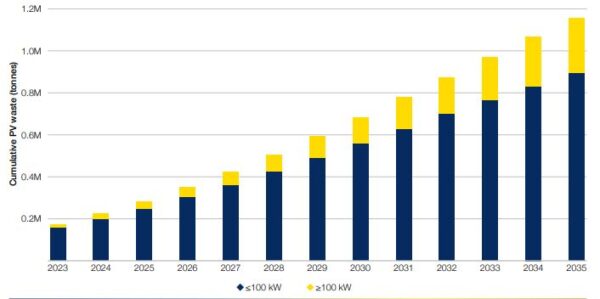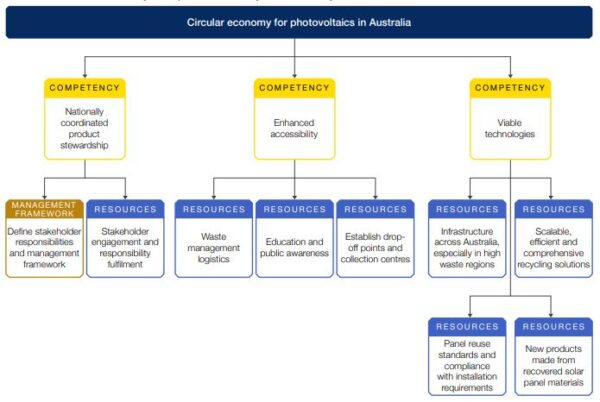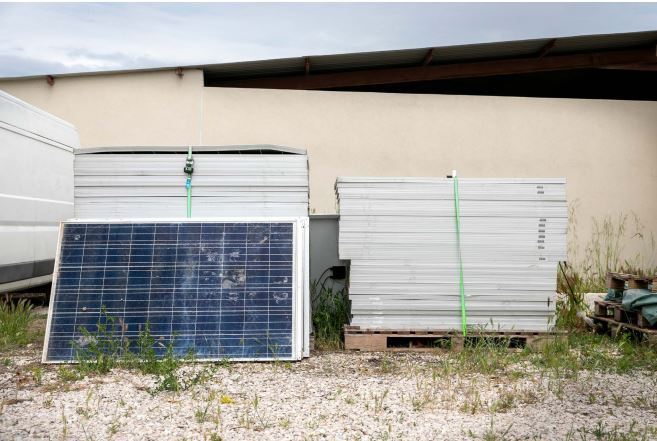Researchers from the Australian Centre of Advanced Photovoltaics (ACAP) at the University of New South Wales (UNSW) say the nation’s solar panel waste problem is more pressing than previously thought with a new report contradicting earlier findings that significant volumes of PV waste would not appear until at least after 2030.
The Scoping Study: Solar Panel end-of-life management in Australia report forecasts up to 100,000 tonnes of PV waste being generated every year by the end of the decade on the way to a projected cumulative volume of 1 million tonnes of decommissioned panels by 2035.
UNSW researcher and report co-author Dr Rong Deng said approximately 892,000 tonnes or solar waste is projected to come from rooftop systems, with an estimated 265,000 tonnes from large-scale solar farms.
“More than 80% of the decommissioned solar panels by 2030 are projected to emanate from small-scale distributed PV systems, attributable to the earlier evolution of Australia’s residential PV market,” she said.
“In the next 12 years, we need a clearly defined management framework, accessible collection methods, and new technologies to transform the challenge of end-of-life solar panels into sustainable business opportunities with positive economic, environmental and social outcomes.”

The report recommends the establishment of large waste facilities in Sydney, Melbourne, Brisbane, Perth, and Adelaide by 2027 as a matter of urgency as part of a broader strategy to establish a national solar panel recycling and reuse market.
ACAP Executive Director Professor Renate Egan said setting up domestic solar waste management facilities is an opportunity for resource recovery and that total material value from end-of-life solar panels will surpass $1 billion by 2035.
“Recycling offers a gateway to reducing landfill, enhancing circular economy initiative, and job creation and the report was developed to provide a detailed analysis of the waste volumes and distributions, needed to prepare for future waste from rooftop and large-scale solar,” she said.
It is predicted the metropolitan sites would handle 5,000 to 10,000 tonnes of end-of-life solar panels annually, with that volume needing to double at each facility over the next six years to keep pace with the growing waste stream.

While the report calls for immediate action on the metropolitan sites, it also highlights that some regional areas are expected to have even faster waste generation growth between 2025 and 2030.
Popular content
These include the Dubbo/Wellington, Newcastle, Balranald, and Murrumbidgee regions in NSW; the Whitsunday, Townsville, Sunshine Coast, and Western Downs regions in Queensland; and Mildura in Victoria.
The report suggests that the Dubbo/Wellington region, in the heart of the planned Central West-Orana Renewable Energy Zone (REZ), has the greatest projected growth with PV waste tipped to soar from 2,500 tonnes of waste in 2023 to a predicted 9,000 tonnes by 2035.
Dubbo Regional Council Resource Recovery and Efficiency Manager Jamie Lobb told pv magazine the council is committed to the circular economy industry as a long-term and sustainable economic opportunity.
“Council is actively exploring solar panel processing opportunities, to be based in Dubbo, to support local community and the renewable energy zone (REZ) projects within and around the region,” he said.
While the exact scale of the future PV waste stream in the region remains unknown Lobb said the council is actively working with industry and regulators on addressing the issue.
“Council’s Economic Development Team are in active discussions with a number of private (local, interstate and international) operators who have the resources, capability and capacity to set up a commercial magnitude solar panel recycling facility in the Dubbo region,” he said.
Lobb noted that interest in the issue has grown exponentially since the announcement of the Central West Orana REZ with the local Yurruga Indigenous Corporation and Circular PV Alliance among those exploring solar recycling opportunities.
Commissioned by the Australian arm of French renewables giant Neoen, the report highlights that high recycling expenses currently hinder PV recycling, estimating it costs about $2 to send a panel to landfill compared to $10-20 per panel to recycle.
The report also highlights the challenge of finding markets for the recycled materials or a suitable domestic market for reused panels.
“Given these challenges, alongside the high costs of recycling and a limited market for the recycled materials, there is a pressing need for more innovative recycling solutions in Australia,” the report says.
This content is protected by copyright and may not be reused. If you want to cooperate with us and would like to reuse some of our content, please contact: editors@pv-magazine.com.


Wouldn’t it be wonderful if our Commonwealth government really invested in recycling and solving the problem of solar panel waste instead of trying to capture a tiny slice of new solar panel manufacture.
Yes I know, not sexy enough
What exactly do Australians do now, put them in the ground like wind turbines I saw in another video? If so, that is extremely sad, that is so much waste that it should be shown to “green energy” activists. Because in our age, these things are not much of clear logical convictions but often pretty much religious believes. They believe in green energy not thinking about what it is and how it is given today. I do not want climate changes to be handled people who are more of believers rather than cold headed rational problem solvers.